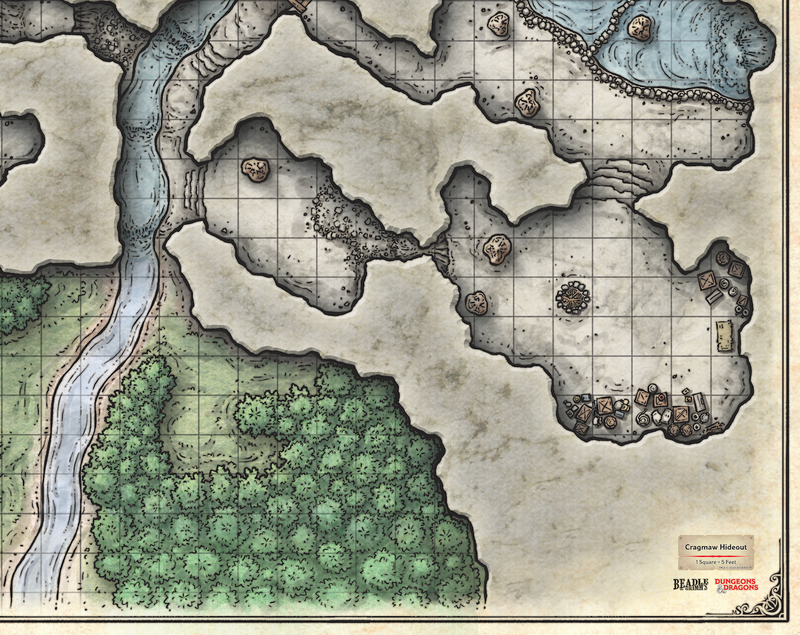
The healing powers of gaming
There have been some tough times for my players this year. One lost a father. One is dealing with health issues with both parents. Another has been going through physical rehabilitation. In all cases, I’ve had multiple instances where those players thanked me and the group for providing a respite from the stresses of life.
To be able to count on one night - a D&D night in an extended campaign that we make a priority - to lose yourself in the epic story, in the laughter and the fantasy.
Don’t underestimate the healing impact.
Back to the game.
The goblins of the Cragmaw Hideout sic the wolves from Area 3 on the party and Twilly, the druid, uses speak with animals, along with a successful Animal Handling check to convince the wolves to go seek easier prey. One of the wolves ends up befriending the druid. Now, I know the spell’s duration doesn’t really suggest it should lead to an animal companion, but when I looked at the treatment of the wolf by the goblins, and the roleplaying of the druid, I decided to allow it, and the player, as you would expect, loved it. And it certainly won’t break the game, because the wolf has a bit of a mind of its own, so it will pick its spots to defend the druid. It was fun to hand the wolf encounter card to the player!
Despite that success, the party tries to get into the Hideout despite the fact that everyone is on high alert and ready. The gushing water trap works - flushing two players out - and the goblins with position prove too much and the party is forced to retreat and recoup, before returning the next day and trying to regain the element of surprise. While this was a session heavy on tactics, I made sure to have Klarg himself call out and threaten/taunt the party before their retreat - setting up a more satisfying final battle in the next session.
MIN-MAXING observation:
What you need to know about Drakir, the cleric, is that the player created this character knowing he was only going to have 1 level of cleric with the Peace domain. Luis concepted this character as a deadly crossbow specialist, and used his human variant feat to take (drumroll please…) Sharpshooter. This is the feat that allows you to ignore half and ¾ cover, ignore long range disadvantage, and opt to take a -5 to hit to add +10 damage.
Some DMs disallow this feat (the -5/+10 ability was removed from the 2024 PHB). It’s pretty powerful if your build is maxed.
So by taking a level of cleric with the Peace domain, Drakir, can greatly reduce the -5 to hit penalty in two ways:
- By casting bless on himself in multiple combats per long rest to add a d4 to attack rolls.
- By using the 1st level Peace domain feature emboldening bond (including himself) to add a d4 to attack rolls.
So with the advantages of that 1 level of cleric, Drakir will progress as a fighter the rest of the way with the Archery fighting style.
As a DM, I don’t want a player doing this ONLY for the statistical advantage. So my challenge to Luis was: create a compelling story reason that your character begins as a cleric and then leaves that path to become a fighter. And where did you get the training for Sharpshooter? (Luis, an amazing roleplayer, is up to the challenge of making that choice interesting, nuanced, and justified.)
RP:
Credit note: I chat quite a bit with my brother Rob, who plays in this campaign, about how it’s going - what to improve - etc. So some of the thoughts I present here for sure came from him and I’m presenting as my own. Rob understands. :-) One discussion that stands out is the idea of story-driven roleplaying vs what I’ll call reactionary roleplaying.
Let’s take a look at Wild Beyond the Witchlight. I personally loved DMing that adventure, but there are a LOT of encounters that are designed to be role playing encounters - either combat would lead to a TPK, or the NPC or creature simply won’t fight. So the players are essentially forced into role playing. Do they sense that? Can that be frustrating in some ways, if presented over and over? I’ll just say it’s possible with some players.
What we’re finding in Phandelver, which has a more straightforward action approach, is that the roleplaying is happening as a result of the combat and high stakes of the story. It is integrated within the combat - leading to a nice mix. Could that be even more satisfying than story-driven RP? Maybe. Sometimes. If you have a DM that encourages RP within the combat, and if you have players that are comfortable enough to thread RP within. Personally, as DM, I get bored with long stretches of combat after combat, but I have to admit - my players have not. Quite the opposite. So I’m adjusting my approach to make it exciting for both them and me.
Next: Session 3


0 comments